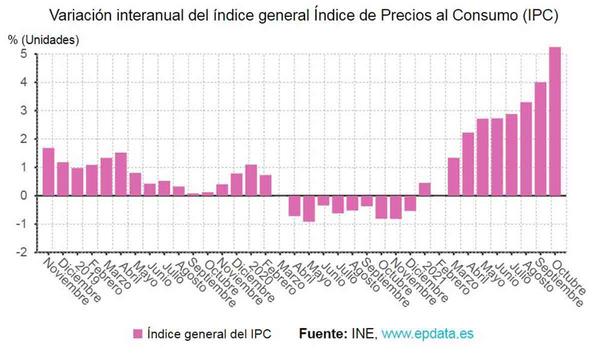By clothing-bag, 22/11/2022
The IPC rises 1.6% during October in the Canary Islands and the year -on -year rate increases 4.2%
Las Palmas de Gran Canaria/Madrid, Nov 12.(Press Europa) -
The Consumer Price Index (CPI) climbed 1.6 points in the Canary Islands between September and October, to place its annual rate by 4.2%, below the national average (+5.4%) and the lowest riseInterannual of the whole of Spain, according to the data published this Friday by the National Institute of Statistics (INE).
This rebound is explained by the increase in housing segments (17.8% more interannual) and transport (8.9% more), which are affected by the increase in electricity prices.
Compared to the same month of 2020, in the Canary Islands all groups present increases except communications, which lower 0.5%, and leisure and culture (-0.1%).Prices increased in hotels, coffees and restaurants (2.1%), medicine (0.6%), chest (0.5%), non -alcoholic foods and drinks (1.3%), teaching (0.7%), alcoholic beverages and tobacco (1.7%) and dressed and footwear (1%).
Meanwhile, in the whole of Spain, the CPI rose 1.8% in October in relation to the previous month and triggered its year -on -year rate to 5.4%, almost 1.5 points above the September rate and its levelhigher in 29 years.The interannual rate of the CPI recorded in October (5.4%) is a tenth lower than the advanced one at the end of the INE (5.5%).In the case of the monthly rate (1.8%), it is two tenth less than the one advanced by statistics (2%).
With the October interannual data, the highest since September 1992, the IPC chains its tenth consecutive positive rate.
Without taking into account the reduction of the Special Electricity Tax, the year -on -year CPI would reach 6.1%, seven tenths more than the general rate in October.This is reflected in the CPI to constant taxes that the INE also publishes within the framework of this statistic.

According to the agency, in the interannual behavior of the CPI, above all, the rise in electricity prices stands out, which in the last year has increased 62.8% including the tax sales applied to the light invoice.Discounting these fiscal discounts, the interannual increase in the price of light would be 86.3%.
They have also influenced the interannual rebound of the October CPI in the increase in gas prices, diesel for heating, restoration and fuels and lubricants for personal vehicles, as well as the fact that telephony prices, ofAccommodation services and tour packages fell less in October of this year than they did in the same month of 2020.
Specifically, the housing group raised its year -on -year rate in October, to 20.5%, due to the increase in the price of electricity, while the transport group increased its rate two points, up to 12.3%, for the highest cost of gasoline.
At the same time, the communications group increased its year -on -year variation more than two points, to -0.5%;The one with hotels, coffees and restaurants raised its rate six tenth, up to 2%, and that of leisure and culture recorded a higher six tenth rate, placing it at 1.5%, due to the evolution of the price of tourist packages.
The gap with the underlying, the highest in 35 years
The underlying inflation (without unprocessed food or energy products) rose four tenths in October, to 1.4%, its highest value from July 2017.
In this way, the underlying is four points below the general index, the highest gap between both rates from the beginning of the series, in August 1986.
In the tenth month of 2021, the Harmonized Consumer Price Index (IPCA) raised its year -on -year rate almost 1.5 points, up to 5.4%, while recounted 1.6% at a monthly rate.
The light pulls the monthly rebound of the CPI
At a monthly rate (October on September), the IPC chained its third consecutive rebound when rising 1.8% in October, one more point than in September.To this increase contributed the increase in electricity by 10%, the rise in diesel and gasoline ( +5%and +2.9%, respectively), as well as the highest cost of dress and footwear, fruits, bread and meat.
In fact, according to INE data, what raised the most price in October compared to the month of September were the other dress items (gloves, belts, umbrella), with a monthly advance of 15.3%;Women's clothes (+13.6%) and men's (+12.2%).On the other hand, what fell in price in relation to the previous month were the national tour packages (-6.5%).
The price of gasoline rises 26.5% in the last year
In the last year (October 2021 on October 2020), what has risen most price has been electricity (+62.8%);Liquid fuels (+57.1%);other oils (+33.6%);butane and propane (+33.4%);diesel (+30.5%) and gasoline (+26.5%).
On the contrary, what has most been cheaper since October 2020 are tolls and parking (-22.4%);mobile phone equipment (-7%);national flights (-3.5%);other computer supports (-3%);Games and hobbies (-2.5%) and nuts and shell (-2.4%).
All communities, in positive rates
The annual IPC rate rose in October in all autonomous communities.The largest rebound in the annual rate, of 1.7 points, was experienced by Castilla-La Mancha, while the lower increases, of a point, occurred in the Canary Islands and Cantabria.
At the end of October, all communities had positive year -on -year rates.The highest rates correspond to Castilla-La Mancha (6.5%), Castilla y León (6.1%) and La Rioja (5.9%).
On the other hand, the communities with the interannual rebounds of more moderate prices are Canary Islands, with a rate of 4.2%;Basque Country (5%) and Madrid and Murcia (5.1% in both cases).
Related Articles